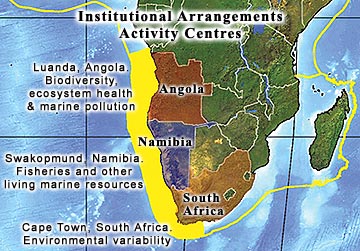|
Institutional Arrangements

The BCLME Programme is intended to serve, in part, as a substantial
capacity-building tool. It is intended that the three participating countries,
Angola, Namibia and South Africa, will work together through the Benguela
Current Commission ato implement an "ecosystem approach" to managing the BCLME.
Implementing Agency
The United
Nations Development Programme (UNDP) is the GEF Implementing Agency
for this project. The UNDP is one of the formally designated GEF Implementing
Agencies and is accountable to the GEF for all aspects of project
implementation.
Executing Agency
The Executing Agency for the project is the United Nations Office for Project
Services or UNOPS. UNOPS has experience in the successful management of UNDP-GEF
International Waters projects. Additionally, UNOPS personnel are well-positioned
to offer to the Programme Coordination Unit the expert services that it requires
to ensure adherence to standard UNDP practice with regard to, among other
things, the recruitment processes, contracting, and the coordination of
monitoring and evaluation functions.
Programme Steering Committee
The Programme Steering
Committee comprises three members from each of the participating
countries, and a representative from UNDP-GEF, SADC and BENEFIT.
Programme Coordination Unit
The Programme Coordination
Unit, or PCU, provides a coordination and management structure for
the development and implementation of the BCLME Programme. The PCU comprises the
Chief Technical Advisor (CTA), Office Manager, Secretary, and contract
personnel.
The Chief Technical Advisor
The CTA is responsible for the overall coordination of all aspects of the
BCLME Programme. He liaises directly with designated officials of the
participating countries, the Implementing Agency, the Executing Agency, UNDP
Country Offices, existing and potential donors, and others as deemed appropriate
and necessary by the PSC or by the CTA himself. The budget and associated work
plan guide the day-to-day implementation of the Project Document and the
integration of the various donor-funded parallel initiatives.
The CTA is responsible for delivery of all substantive, managerial and
financial reports from and on behalf of the Project and provides overall
supervision for all GEF staff in the Programme Coordination Unit.
Activity Centres
An Activity Centre is
located in each of the three participating countries. The Activity Centres have
been created through in-kind contributions by the governments of the
participating countries, as well as with significant funding from donors.

-
The Living Marine Resources
Activity Centre, which is responsible for issues related to living marine
resources in the BCLME, is located in Swakopmund, Namibia.
-
The Biodiversity, Ecosystem
Health & Pollution Activity Centre, focuses on issues related to
biodiversity, ecosystems and pollution and is located in Luanda, Angola.
-
The Environmental Variability
Activity Centre, is located in Cape Town, South Africa, and focuses on
issues related to environmental variability and predictability.
Working with and through the CTA, the directors of the three
Activity Centres are responsible for developing and coordinating the work of the
Activity Centres and assisting the Advisory Groups assigned to their respective
Activity Centres.
Advisory Groups
The Advisory Groups provide technical expertise to the BCLME
Programme. They are required to provide the PCU with the best possible advice
and information on topics key to implementation of the BCLME Strategic Action
Programme. They also translate a part of the overall budget into specific
projects and activities that will address transboundary problems.
The Advisory Groups consist of two members from each of the
participating countries.
|


